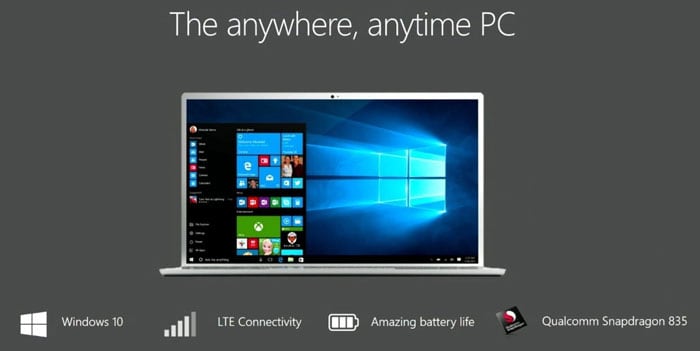Today during Qualcomm’s Tech Summit keynote, Microsoft and Qualcomm unveiled the first Always Connected PCs powered by Qualcomm’s Snapdragon 835 processors. These type of PCs, such as the ones from HP and ASUS are running Windows 10 on ARM, and they can deliver all-day battery life, better security, and much more. Microsoft’s Terry Myerson came on stage today to briefly talk about these Windows 10 on ARM PCs, he later detailed the benefits of this new platform via a post on the Windows Experience Blog.
According to Myerson, Always Connected PCs enable a new culture of work, since they are instantly on, provide great battery life and are always connected to the Internet. The exec said that he already used a Windows 10 on ARM PC for watching movies, working in Powerpoint and checking email, and shared that he did “all of this without plugging in my power cord all week.”
Here are the exec’s exact thoughts on the other benefits of Always Connected PCs:
This new Always Connected PC is ultrathin, beautifully designed, running Windows 10 and a new, optimized version of Office 365. But beyond the full experiences you’d expect in a PC, this new Always Connected PC has fundamentally transformed how I work, because of three significant advantages over my other PCs.
- The screen is instantly on whenever I pick up the device. I never have to wait for it to wake up, it’s just on.
- Being always connected wherever I am whether I am in the car, airport or coffee shop, always being connected just feels like the most natural, safe and secure way to work with teams and be creative.
- Lastly, the battery life is just awesome! I am finding myself charging it once a week. When I was using a wearable that needed to charge every day, I didn’t really rely on it. Once I moved to a Fitbit that only needed charging once a week that was game changing for me. Not carrying around power cords is liberating.
Always Connected PCs also have benefits for organizations and businesses, including better security since they won’t need to connect to unsecured public WiFi networks. Additionally, these type of PCs can run either Windows 10 or Windows 10 S: the first models from Asus and HP will actually run the more secure Windows 10 S out of the box, but customers will be able to upgrade to Windows 10 Pro for free for a limited time.
The first Windows 10 on ARM PCs are expected to go to market in 2018, but we’ll likely see more of them at CES in January. There is definitely a lot of excitement about Windows 10 on ARM right now, but the first models won’t be based on Qualcomm’s latest and greatest silicon: indeed, the company also announced its new Snapdragon 845 processor today, which will likely we found in all flagship Android smartphones next year.
Qualcomm’s Snapdragon 835 remains a very good processor today, but we have yet to see how legacy Win32 apps such as Photoshop will work on these first Windows 10 on ARM PCs. If the built-in x86 emulator in Windows 10 on ARM can really deliver performance that matches what we find on PCs with Intel and AMD processors, then Microsoft and its OEM partners can well have a hit on their hands.


